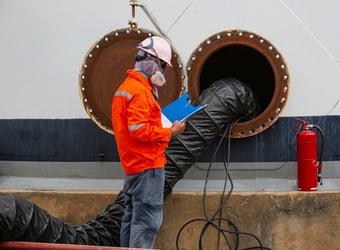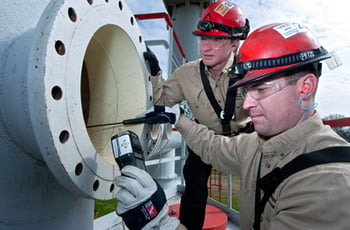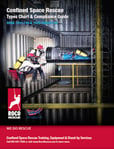Ventilation for Confined Space Rescue
Vent Early, Vent Continuously, and Vent Properly.
During a confined space rescue scenario, performing ventilation can have a huge impact on achieving a positive outcome at the incident. With few exceptions, there is no downside to ventilating in a confined space, but the upsides can be literally life changing.
In the simplest terms, ventilation is the process of circulating air with the goal of removing “bad” air (oxygen-deficient, toxic, explosive, etc.) from a confined space and replacing it with “good” (fresh) air. There are different methods to accomplish this task, but each with the same basic goal. In most cases, ventilation is an attempt only to control or mitigate a hazard rather than eliminate it. If ventilation ceases for any reason, the hazard may rapidly return.
 Ventilation serves several important purposes. It improves the environment for the victim by directly removing or diluting the contaminants in the space. By creating a flow of air, ventilation can improve the ambient conditions of the space which can be extremely helpful for a victim’s status. Lastly, and of equal importance, ventilation also improves the operating conditions for the rescuers, which is critical as well.
Ventilation serves several important purposes. It improves the environment for the victim by directly removing or diluting the contaminants in the space. By creating a flow of air, ventilation can improve the ambient conditions of the space which can be extremely helpful for a victim’s status. Lastly, and of equal importance, ventilation also improves the operating conditions for the rescuers, which is critical as well.
Vent Early
If a victim is in a bad air environment, the clock is ticking. Of course, the exact contents of the space ultimately determine survivability, but the point is, there is not much time regardless. And getting rescuers into the space and in contact with the victim may easily take 4 to 6 minutes or much longer. Ventilation, on the other hand, can be quickly activated outside of the space and at work removing contaminants almost immediately. It is one of the single best things rescuers can do early in the incident.
The first step in venting early is understanding the space where rescue will be performed. This is where effective preplanning really pays dividends. After understanding the potential hazards, one of the first pieces of information rescuers will need is the dimensions of the space to be ventilated. Since air is measured in cubic feet, multiply the width times the height times the depth of the space (in feet) to arrive at the cubic feet of air volume.
Ventilation is the process of circulating air with the goal of removing “bad” air (oxygen-deficient, toxic, explosive, etc.) from a confined space and replacing it with “good” (fresh) air.
The next piece of critical information is the size of the fans that will be used for ventilation. Fans are measured in—or rated by—the cubic feet per minute (CFM) they will move. Take the total cubic feet of the space and divide it by the fan’s rated CFM, and you can determine how long it will take to exchange the air in the space. The faster the air can be exchanged, then the lower the toxicity levels, the lower the percentage of lower explosive limits (LEL), the higher the oxygen levels, and the more fresh air is circulating around the victim. So, when it comes to fans, bigger—or at least “bigger” CFMs—is definitely better.
Another important part of the preplanning process is to identify the ventilation openings for the intake and its path to discharge. Ideally, both of these points will not be the entrance from which rescuers expect to effect the rescue. But often this is not the case. When assessing these locations, it is important that the intake air be drawn from a non-contaminated source and that the discharge air will not spread contamination to people or equipment. This is also a good time to consider where and how ducting will be executed.
Preplanning should also take into consideration the interior of the space. Is it a wide-open vessel? Or are there obstructions—such as trays or mixing equipment—that can obstruct airflow and create dead air spaces? The configuration of the space can interfere with ventilation and may require extra or larger fans to adequately move air through it.
 At the declaration of an emergency, deploying ventilation and performing air monitoring should occur concurrently with size up. Starting ventilation is like applying a cervical collar at the scene of an automobile accident; it is one of those things you know you are going to perform each and every time. And while it is expected that everyone will be appropriately trained, ventilation can be handled by support personnel while the rescue technicians are readying for entry.
At the declaration of an emergency, deploying ventilation and performing air monitoring should occur concurrently with size up. Starting ventilation is like applying a cervical collar at the scene of an automobile accident; it is one of those things you know you are going to perform each and every time. And while it is expected that everyone will be appropriately trained, ventilation can be handled by support personnel while the rescue technicians are readying for entry.
This is the time to gather baseline atmospheric data about the space with air monitoring. Because gases can have varying weights (meaning they may float or sink), OSHA requires measuring intervals of every four (4) feet. As highlighted earlier, this underscores the importance of identifying the space’s dimensions and configuration.
It is highly desirable to monitor the space prior to the commencement of ventilation. Knowledge of the baseline monitoring results better arms the rescue team to deal with the space in terms of their own protection, thus possibly affecting equipment choice(s). With continuous monitoring, the value of ventilation can also be unequivocally realized with increasing oxygen levels, decreasing toxicity, and decreasing percentage of LEL. It is this improvement of the space’s atmosphere, with so little comparative effort, where the beauty and value of ventilation lie.
Vent Continuously
Most industrial standard operating guidelines require five (5) complete air exchanges before entering a confined space. But this is under working conditions. During a rescue, there may not be time for that degree of ventilation to take place. This again highlights the vent early aspect of response.
By venting continuously, you are constantly improving the interior conditions. Ventilation operates under the premise of increasing returns—the longer it is performed, the better the conditions inside of the space. And the conditions will continue to improve so long as ventilation is provided. This is why it is vitally important to never interrupt ventilation once it has begun.
If electric ventilation fans are used, try to ensure they are on an uninterruptible power supply if possible. If generators are being used to supply power, ensure there is ample fuel.
In concert with the continuous ventilation, there should be continuous air monitoring. It is important to continue to identify any areas where readings are not improving. If the ventilation has been set up and sized properly, the air monitoring results should reveal a steadily improving atmosphere (as long as hazards are not actively being introduced into the space). In some instances, remedying problem ventilation areas may be something as simple as adjusting the ducting.
Vent Properly
Ventilation supplies the aforementioned stellar results only if it is done properly. And there can be no question that performing ventilation properly is a matter of both science and mathematics. It is a quantifiable problem.
But in the real world with a relentlessly ticking clock, once the basic dimensions are known, there is also a degree of “voodoo magic” that comes into play with being able to read the space and quickly determine the ventilation inlets, outlets, and configurations inside that may impede airflow. That “magic” comes with training and experience. While most rescuers want to spend their training time performing the glamour skills—such as rigging and patient packaging—it is important to remember that in a bad air situation, it will be ventilation that can have the greatest immediate effects. In training, teams need to quit only verbalizing that ventilation is set up and actually perform this lifesaving skill.
Setting up ventilation is a great task both for new team members or for those in technician training. The rescue leader or ventilation officer of course decides the ventilation plan, but actually setting up the equipment can be delegated to new or support personnel. It is a crucial task that needs to be completed and provides immediate and tangible results while positively affecting the outcome of the incident.
In the rescue world, ventilation is similar to rope—you need the right size and the right amount.
How to perform ventilation properly can be a course in and of itself and is a topic that carries with it some debate. The debate usually centers around positive pressure ventilation versus negative pressure ventilation. But when applied correctly, both are proven performers in ventilation. It is the proper use of the equipment on hand that actually matters when it comes to performing effective ventilation.
So, while neatly avoiding the ventilation debate or getting too far into the weeds with a how-to course on ventilation, we will address some of the more salient points with ventilation that should be considered. These are the kind of things that, if not done or done wrong, can impede your ventilation efforts and/or create an unsafe environment.
In the rescue world, ventilation is similar to rope—you need the right size and the right amount. Bigger, more powerful ventilation fans move more air, help eliminate dead air spaces, and exchange the air in the space quicker. If larger fans are not available, it is often possible to use multiple fans to increase airflow. Ducting fits into this “rope” category as well—it is paramount to effective ventilation, so it pays to have plenty of it. Fan manufacturers provide guidance on how far ducting can be extended to or from their fans and how it affects the capacity or the amount of air moved.
The next important thing is to be familiar with the equipment. Seeing equipment for the first time at an emergency is unacceptable. This stresses the importance of training with your gear and developing competency with it in advance of an incident. It is also most definitely advisable to follow the equipment manufacturer's instructions with regard to use and cleaning.
 Just as important as the fans is a solid air monitoring plan. The rescuers should be aware of the potential atmospheric hazards and have obtained the appropriate monitoring equipment. The air monitoring should continuously measure the entire space with results constantly provided to the vent team; this allows for adjustments if a particular part of the space is not seeing the expected improvements in air quality.
Just as important as the fans is a solid air monitoring plan. The rescuers should be aware of the potential atmospheric hazards and have obtained the appropriate monitoring equipment. The air monitoring should continuously measure the entire space with results constantly provided to the vent team; this allows for adjustments if a particular part of the space is not seeing the expected improvements in air quality.
It is also critical to consider the intake air source and the discharge path for exhaust or discharge air. Since fresh air will be sent to the victim, it is imperative that its source be free of contaminants. In the same regard, the hazardous atmosphere from inside the space is also being vented somewhere. This location should be free of personnel and equipment or any other environmental concerns.
If your team is employing positive pressure ventilation, there will almost always be some degree of (and often all of) the exhaust occurring at the rescue opening or portal. This means that the outside team is probably being exposed to the space’s atmosphere. Therefore, air monitoring should be conducted in their vicinity continuously while ventilation is in progress. These crew members may very well need to wear PPE to protect them from the hazard. Neglecting topside air monitoring is a frequently overlooked step that can have dangerous consequences.
Ventilation is a foundation skill that often does not receive the attention it deserves. Short of supplying breathing air directly to the victim, there is no more effective step than ventilation for improving air quality inside of a confined space and ultimately the survivability of the victim. We encourage all rescue teams to include ventilation as a standard part of their rescue training regimen. And when at the actual emergency… vent early, vent continuously, and vent properly.

Additional Resources
- Confined Space Types – Are All Your Bases Covered?
- Confined Space Rescue Types Chart & Compliance Guide (pictured here)




